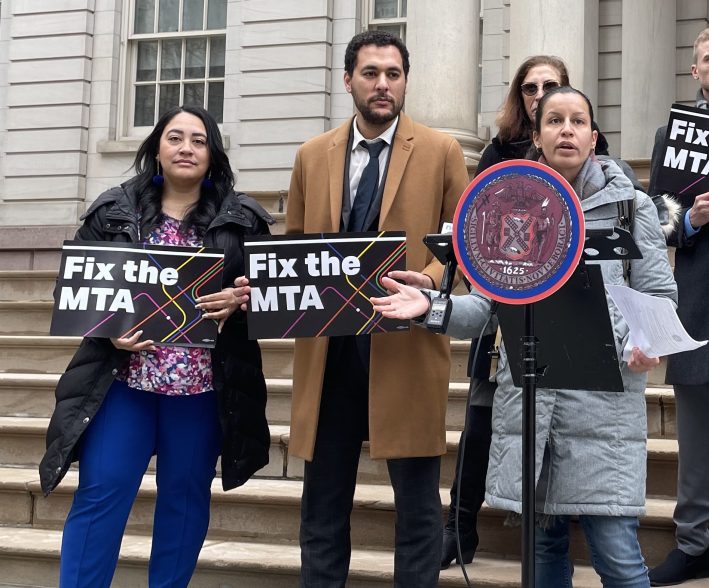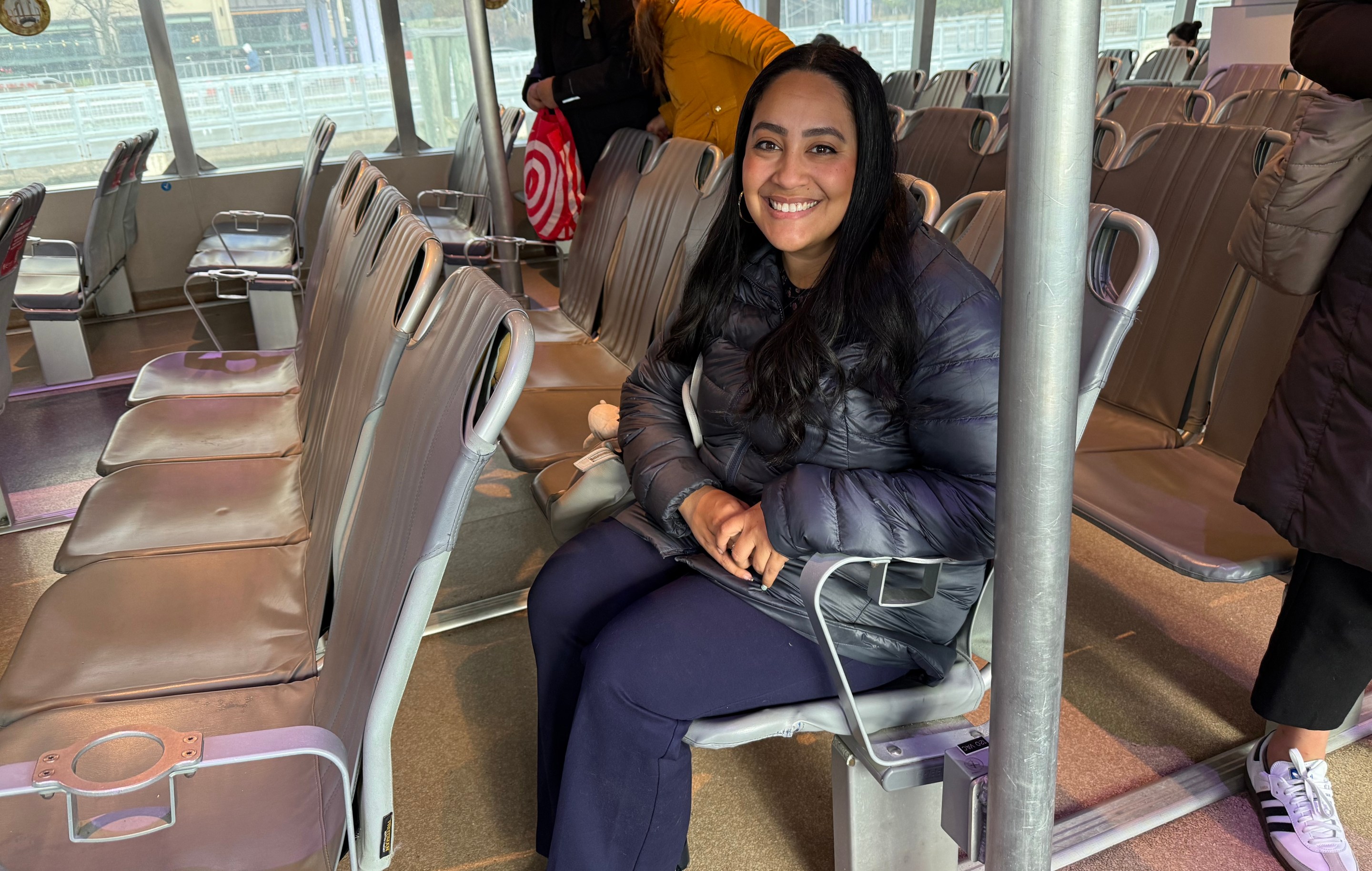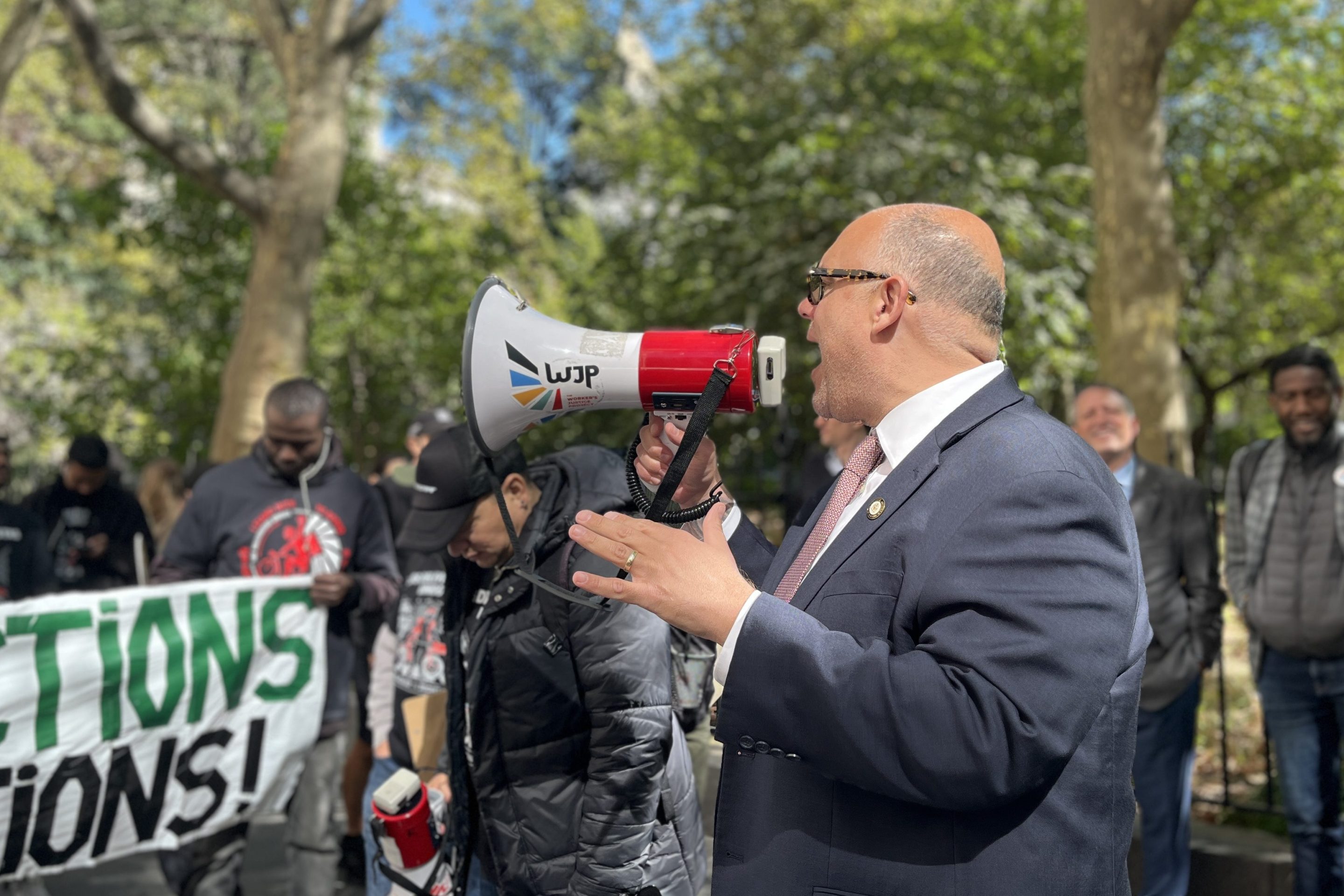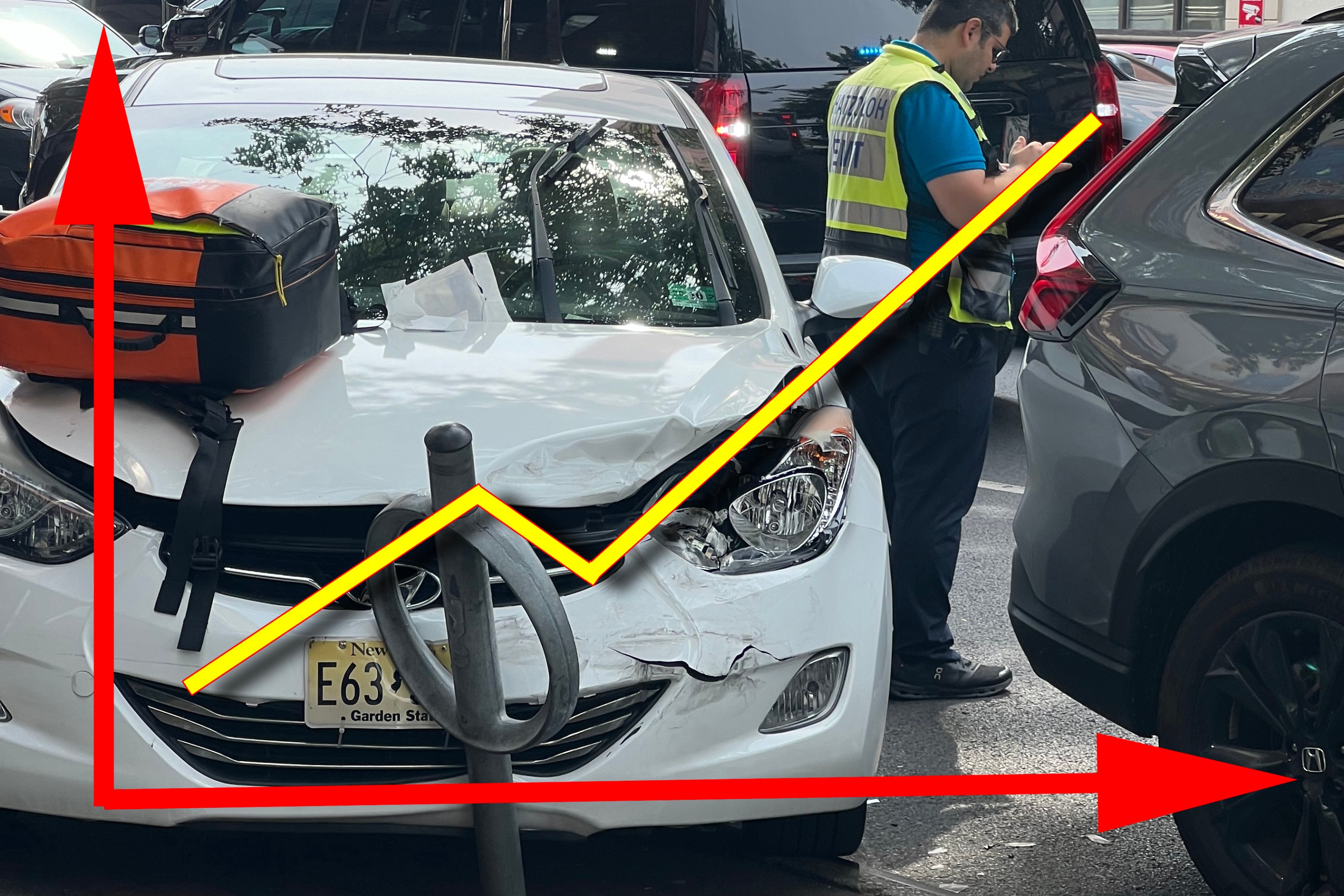In 2026, the city will welcome (and, if history is any guide, slowly come to hate) a new mayor. But that's not the only change happening in city government. The City Council will elect a new speaker to set its direction on a myriad of policy proposals. The members vote for their boss early next year, which makes the process somewhat opaque. Frontrunners reportedly include Council members Crystal Hudson, Julie Menin and Amanda Farías.
Menin declared victory right before Thanksgiving — earlier than any speaker candidate in New York history — but with weeks to go before the actual vote there is still time for Council members to reconsider. The "vote pledges" that Menin has in her pocket are worth only a little bit more than the press release they're printed on, and as one reporter once said about the shifting sands of these alliances, "politics ain't beanbag."
So, we're still going to run our interview with Farías — especially since Menin has steadfastly declined to answer questions from us about her financial ties to Uber and association with the revanchist E-Vehicle Safety Alliance.
Farías, in contrast, has thrown her hat into the ring as the self-described Transportation Candidate for the position. The Bronx representative is a former Riders Alliance board member, and has supported congestion pricing, six-minute service on subways and buses. She also had a central role in guiding the rezoning around the upcoming Metro-North stations in the Bronx and has been a proponent of the NYC Ferry system and brought a reduced fare program to the service.
As the Council deliberated on who will succeed Speaker Adrienne Adams, Farías took a ferry ride with Streetsblog from Soundview to City Hall to pitch her vision on the crucial issues facing our city, including the future of the Streets Master Plan and how well Council Member Selvena Brooks-Powers managed the Transportation and Infrastructure Committee, on which she serves.
Streetsblog: You're pitching yourself as the "transportation candidate" for speaker. What goes into that?
Amanda Farías: I came into the Council as a transit advocate, someone that was a board member of Riders Alliance, someone that helped with the bus redesign plan that they had in the Bronx, and was really excited to come into the City Council as someone that can reimagine the neighborhood.
I ran on, and have been successful at micromobility hubs and trying to connect all of our transit. We're a transit desert in my district, and so over the last four years, it's been really important for me to find the appropriate places to have protected bike lanes, shared bike lanes, that can connect the ferry that we're on, the 6 train, to all of the major busways that we have in the district, to help people be more mobile and have their commutes be cut down. Transportation and mobility, ease of mobility for commuters and pedestrians has been a priority [for me].
So as speaker, what would all of that mean if you had that focus on transportation?
Amanda Farías: I think it's a lot of the continuation of things we've been focused on. The redesigns in communities, really looking at with DOT and with Council members what their communities are missing in terms of connectivity. I'd really like to see the expansion of e-scooters. I know it's been a little contentious in other boroughs, but it's been really successful in my district. I'd like us to keep focusing on things like daylighting, I just got onto the daylighting bill.
I think the Council has to take on with the administration not only improving our streetscapes, but also dramatically improving safety. In my district, in the last handful of years or so, we've had over 23 deaths, including young people and elderly folks. To me, that's just not appropriate when those things can be preventable.

How do you think that you would manage these kind of relationships that you have with other members of the Council? You mentioned with the scooters, sometimes there's push back. And obviously with bus lanes and bike lanes, you have a mayor coming in who wants to be very aggressive with them. So how do you see yourself in managing those relationships when the incoming mayor says, "We've got to move fast on this stuff"?
Amanda Farías: I think this is the best part of what I get to do now, and I'm hoping I can expand upon it and be more hands on as a speaker. The role I have in helping members with their land use items right now is utilizing the Community Engagement Division, pulling in comms, helping them strategically look at their plans, those that are appropriate. All of the members are fully capable of having their own comprehensive plan and how they engage their community, but I think where I've seen the most success is starting early, going into communities with engagement, having sessions.
When I had the Bronx Metro-North redevelopment plan, I used the Community Engagement Division and the communications team and the Land Use division. We had six or seven additional input meetings with the architects. They built models, like they showed people what it would mean. We had graphics and activities up for people to understand more in-depth, what the development could mean for the community, what it could look like. And I think that is what we're missing right now. It was part of my testimony in the Charter Revision Commission hearings DCP, HPD, the agencies themselves they're not going into the communities and having in-depth meetings with community members to help them understand why some of these things are necessary. It's more like we've made a decision and we're telling you we're going to do it.
I think that's where a disconnect is. That can be a role of the speaker's office, working hands-on with members and the agencies to ensure communities feel empowered by some of these decisions that are being made, they're doing them with them and not just being told it's going to happen. And obviously I hope that happens in collaboration with the administration, that we take a deeper approach to having people understand how the city functions and how it functions in their backyard, and not just them waking up one morning and seeing construction on their street and not understanding.
With these larger Metro-North redevelopments and bigger city planning projects and things that are going to add housing units, that's understandable, but on something like a bus lane or a bike lane, do you think that kind of hand holding, and slow shepherding along is helpful?
Amanda Farías: These folks have to go to the community board already. So what they're doing now is just checking off a box and presenting at one community board meeting to 40 or 60 people. What we could be doing is having a more detailed community board meeting, we're inviting the public to say, hey, DOT is presenting their busway plan, or they're presenting new spots for the e-mobility hubs. When I get that list from DOT, I reach out.
I have a co-governance model in my office, I reached out to that team of people, they disseminated that information. It was a pretty quick turnaround, but we got feedback on where people thought their recommendations were challenging or were helpful. We got more spots. We asked for spots to be eliminated. And I've never had a contentious relationship with DOT, because they've taken that feedback from me and they implement it.
At the speaker's office, I would like to implement how we have Community Engagement Division. We already do participatory budgeting, a co-governance model out of the office that also helps manage participatory budgeting. You also should have a team of people in your office helping you implement plans, giving you feedback, keeping the community or their building or their neighbors up to date with what you're doing. It's been really successful in my district office, and I'd like to see that Council-wide. And I don't necessarily view it as handholding. I view it as us engaging more people, even if it's the small turnaround of 30 days. Most of the time we're given ample amount of time to give feedback. It's just what are we doing with that information, and how are we bringing it back to the community, if we are at all. I'd like to be more proactive than reactive, that's how I've done it in my office.
The Council is an oversight body, so how do you view the idea being of doing oversight of the DOT and of the mayor's office when Zohran has been pretty out front saying fast buses, daylighting, more bike lanes. What is an oversight role in that instance?
Amanda Farías: As you're familiar with we have a lot of previous goals that this new administration is going to come into that we have not actually met. And I think those are the first conversations that have to happen. There are clear set goals, I fully expect to have strong oversight over the missed goals that we were promised by certain deadlines that have not made it.
But also, I see a real need for a strong partnership with the administration heading to Albany for some of these things. That's where I hope to have a plan with the administration on the Council side, where we have our priorities, but also priorities that align with the administration, because this will be the first couple months that we're going to have to fight for dollars to come back down to the city in variety of ways, which includes transportation goals.
One of the problems some people have suggested about the Streets Master Plan is the city should have just said, this is the plan, this is the network we're building, this is what we're doing. As opposed to, they put out the plan and they said, well, here's some priority areas we hope to get to. Do you think it's something that would be a more set plan, you know, the network is going to be, this would be more palatable and make it easier to get through?
Amanda Farías: The way my brain works, it would be easier to have a plan laid out with phases that seemed more interconnected than having spot priority areas. I think that's part of the problem that I've even had in my district with bike lane implementation. I've tried to look at my district and say, Okay, well, this route can go here and it should connect to this route, but at some point my bike lanes end, and that's not okay for communities.
So I think phasing things out and and rolling them out, not only with implementation, but information and outreach and how it's going to happen can also help with budgeting, understanding what we need and at what point and what timeline to see how realistic things are. Obviously, I would agree that a comprehensive plan with phasing is far better than spot priority areas. With the limited amount of time an administration has to accomplish goals, as we've seen we have now a one-term mayor, I think it's important to be able to pass on something more comprehensive than what we have now.
As an overarching philosophy, do you think that we need to deemphasize car use in the city, have fewer car trips, get more cars off the streets?
Amanda Farías: I think it's important to reduce congestion overall. I was born and raised in the in the Bronx, where Asthma Alley and the Toxic Triangle are. We grew up with all sorts of trucks and highways and parkways in the area, intercepting where we get to play outside and live. I think it's important to reduce congestion for for the city, I think we're seeing some some success with congestion pricing right now. It is a priority for me.
The DOT has a partnership with Zipcar, and I have some locations in my district. While it's not necessarily getting cars off the road, in my district we've had over 60,000 individual uses of Zipcar. Those are families that are now not purchasing cars because they have this when they need to make their weekend appointment or drive to their mother's house. So I think we have a lot of innovative ways that we can keep encouraging people to not take on an economic expense like a car that also adds congestion and also adds another car to the street, while their family is growing. I'm always here to encourage multi-uses of our public transit system and a reduction of cars on the road.
My colleague, Sophia covered the Metro-North rezoning and the transit-oriented development push. There was a lot of talk about parking, preserving parking, creating parking during those discussions. Do you see that as a little bit contradictory, you being the transportation candidate for speaker?
Amanda Farías: No, not at all. I think we have to meet the needs of the families that we that are living within our city, and the Bronx Metro-North redevelopment was a perfect time to talk about parking because there was already an existing parking lot and parking garage, and the questions was can we expand those spots there as we're building more housing on top of it? I think there's always going to be appropriate places to talk about parking or adding bike lanes, whatever it is. To me it's about making sure we're coming into communities and we're serving some of the asks that are coming directly from there. Parking came up a lot, but I didn't put parking in every building. I put parking in the building that already had a lot, and I asked them to expand that a few more spots to make sure that with 2,000 housing units we were bringing in, at least people could have available spots to them.
I think there's ways to do it without saying we're bringing hundreds of spots to an area, but still being able to understand that we're going to build two and three bedroom [apartments]. Not every family that has two or three kids is going to want to hop on a bus or spend the money to take a cab every time they need to go somewhere as a family. I think all of those things can happen at once. This is New York City, it's okay to do that.
So you don't worry that it encourages car ownership?
Amanda Farías: No, the people in Parkchester already have cars. What I've been trying to do is say, we're getting a station, maybe you don't need that car anymore, maybe your commute down to 34th Street is shorter because you're going to be able to get on the station. But I think that that will come with time, when systems actually work. And I think that is the thing that we should be aiming for, is making a transit system that is reliable and that is consistent for commuters. I think that's the challenge that we have.
My mom commutes from Parkchester to the Soundview ferry line, she comes to take the ferry because she feels this is consistent, she knows in the morning she's never going to be late, because this is going to come on time every time. She doesn't get that reliability on our 6 train all the time. I think that's what's more important to get people to the places where we need them to be, is providing reliable, consistent, affordable service on our city transit.
Another parking question. I was looking through some of the bills that you've sponsored, and one of them would put a parking permit enforcement division inside DOT. Can you, can you talk about that bill a little bit?
Amanda Farías: It was a sponsorless bill before I came in. So it's a bill I picked up from a past Council. It's supposed to create a parking enforcement division out of DOT, where they're making sure there's no placard abuse and or permit abuse throughout our communities. It has not had success in the first two years after a hearing. I haven't been able to get it on a hearing this cycle, but it is something that I plan to revisit with some advocates to see if it's still a need. I think in the past hearing, the public wanted it. The administration didn't seem like it was necessary, they were already handling enforcement.
Can you give people a look inside the City Council? The Adams administration doesn't want the bill. There obviously have been things that the Council has tackled that the mayor doesn't want to do. So has this bill not been a priority for the Transportation Committee chair or for Speaker Adams?
Amanda Farías: I don't really think it's been a priority for members either. It doesn't have a lot of co-sponsors. I tried to pitch it the first two years. That's when I got a hearing initially. I wouldn't say it's not a priority for the Transportation chair or the speaker. It just hasn't really picked up any traction in the Council at all, and so it didn't really move this cycle, but I'm holding on to it.
How have you seen the daylighting bill working as it's gone its way through the process? It's been this is one where the Adams administration has said we don't want to do this, the DOT has been very hostile to it. It's been interesting to watch some members come aboard it. How have you seen that one work from the inside?
Amanda Farías: I think the prime sponsor is doing everything she can to negotiate in good faith and get some good amendments in, and I'm going to leave that to the prime sponsor to do. I trust Council Member Won doing that. I think there's been a lot of good information coming from the organizers to the members and understanding our districts and how this would help impact, or the lack thereof in terms of people dying, children and old folks.
These conversations around daylighting, sometimes they turn into people saying, Well, okay, in a school zone, we like it around schools, we don't like it around a residential area. Are you a proponent of truly universal daylighting?
Amanda Farías: Yeah. I've implemented a bunch of it in my district already, I've already done a lot of that. I sat with folks from Open Plans in my Land Use and Transportation Committee meetings, to go through what the daylighting bill was and what it meant and what it would look like. I think some folks were a little nervous about the amount of parking spots that it could take. But I think it's important for us to help people understand what comprehensive planning looks like in a community. And it's also important for people to understand it's not going to be every single corner at every single intersection throughout the entire neighborhood. For me it's always been how do you approach people with all of the information that they need to actually know, when and if we pass something, how it gets implemented and what implementation actually looks like. I find that sometimes in the transit space, we end up where the the very drastic measures or the very drastic points are the ones being repeated over and over and over to community members. We know that's just not going to be the case.
For example, in my district, they said there's potentially over 1,500 parking spots that would be removed in the current state of the bill. Some community members were nervous about that. But then when we look at a map and we look at streets, we said 'Well, we already have something here. We already have some daylighting here, these intersections won't be touched.' I think it's just about how you're bringing this information to communities to help get them bought in and help them understand. Most people want their communities to be safe, they want to be able to cross the street and have their kids go to the store for them without thinking about their safety. It's not my bill, so I can't negotiate it, but I think our city is a little behind on stuff like that. When you go to other cities, and you go to other countries, they've done this really well, and we're kind of behind. So it would be nice to not get notifications about an elderly man or a child getting hit by a car due to a driver's blind spot. Which is not their fault, per se, but it's the way our streets are currently constructed that haven't prevented
that.
How, how would you say Council Member Brooks-Powers has done as Transportation Committee chair? We've tangled with her quite a bit on on our issues. Do you think she's done good a job in that role, would you put her back in charge of Transportation Committee?
Amanda Farías: I prefer not to talk about a specific member, but I really enjoyed being on the Transportation Committee, and I feel like for me personally, as someone who has a lot of transit-focused issues in my district, when I brought them to the chair, she's taken them into consideration, she's had hearings on them, she's incorporated my bills. I do think the committee is also very large, and she's tackling a lot of issues. I've always felt as a member on that committee, I'm being heard.
Were you supportive of giving the e-bike licensing bill a hearing, Bob Holden's bill for licensing e-bikes and e-scooters?
Amanda Farías: Was I supportive of it? What do you mean? Supportive? (Note: Farías is a sponsor of the bill)
It got a hearing, and I think that some people, you know, on livable streets side of things, weren't saying, like, what are we doing here? You know?
Amanda Farías: Where I've stood on it was to advocates and to members, and at least to the Speaker's office, was we need to find whatever the middle ground is for this concept. I don't really know what that is. I think I've had so many conversations about street and pedestrian safety, and also what it means on over policing and enforcement. I wouldn't say I was supportive or not supportive as a member of the committee. I was happy to see that it was finally on so a larger conversation can happen. But I know there's a lot of contention around specifically how that bill is formatted right now, and what type of outcome would come from it versus what communities are desiring to see. It's been a topic that was very challenging to maneuver and I don't know if we've gotten a different version of that bill that feels amenable to the membership.
As Speaker how would you handle something like that?
Amanda Farías: I think the the street safety with the licensing problem is something that I would like to see a task force developed on. For me, someone that's crossed the street and had a cyclist or a delivery worker literally run over my feet and run a light, those are things that are really happening every day. So there's a safety component that I think people want to see something come of it. But there's also an individual worker safety component and a street safety component that we have to think about.
So as speaker, maybe I would put together a task force to have people talk about that specific topic throughout the city, with stakeholders, with some of the organizations, any of the bill sponsors. I don't know who will potentially carry that bill next cycle, off the top of my head, but I think there are some issues that the speaker can utilize her ability to create task forces and committees to focus in on some of the more challenging components of bill drafting that we have throughout the city.
You had the six minute service resolution. But something that the MTA has said is there's an issue of you can pay for as much bus service as you want, but if the buses are stuck in traffic you're just gonna have twice the amount of buses stuck in traffic. Do you have anything that you would like to see done that would make something like six minute service a more feasible service templat
Amanda Farías: The thing I've spoken about most with the MTA or other transit folks was looking at ways that maybe communities could make routes shorter. The problem I have in my district is the Bx39, the Bx22 they come from literally across the Bronx, all the way through, and there's spaces where they just can't get out for a while. I know that's a bit more challenging based off of where the bus depots are and how buses have to commute through. But I'd like to see some thought put into where we have train lines and where we have major bus routes that have to go through huge transit areas that have a lot of congestion.
That's been my general thought and conversation with folks on what's feasible, what's not. I did a ride along with the NYCT President [Demetrius] Crichlow on one of my buses, the Bx5 bus, where we have a bus lane but the large problem that we have is the double parking that prevents it to actually utilize the lane completely. Of course, the day that we went, there was rarely any double parking, because that's how it works, right? But we did see it in different pockets, and we did see it in different areas. And so I think bringing people into the districts and having them see where some of these things are, and having better enforcement of the bus lanes and things like that are just going to be helpful for community members.
When I go to community boards, when I go to any any community meeting I'm consistently promoting to folks that when they go to drop off their kid it needs to be the 30-second drop off, it can't be the 15-minute drop off. I think better communication on that to community members is important too. I hope there could be a more collaborative approach to some of that planning and maybe reimagining, reconfiguring to help with six minute service, especially in areas like mine that just have one train station.
Do you think the city has to look at different designs for bus lanes? Is that something that you would see as a role as oversight in the streets master plan or DOT oversight? How do you get people to not double park in the bus lanes?
Amanda Farías: I just think it's going to be more enforcement. I think these types of things always come down to, are they being enforced? And are people understanding what enforcement looks like with a ticket? I think there's areas in my district when the bus camera system came in play, people don't double park there anymore. I don't necessarily want to say that we should be penalizing everyone in that way, but I do think it is an effective tool, and I think will continue to be an effective tool that the busses are using.






